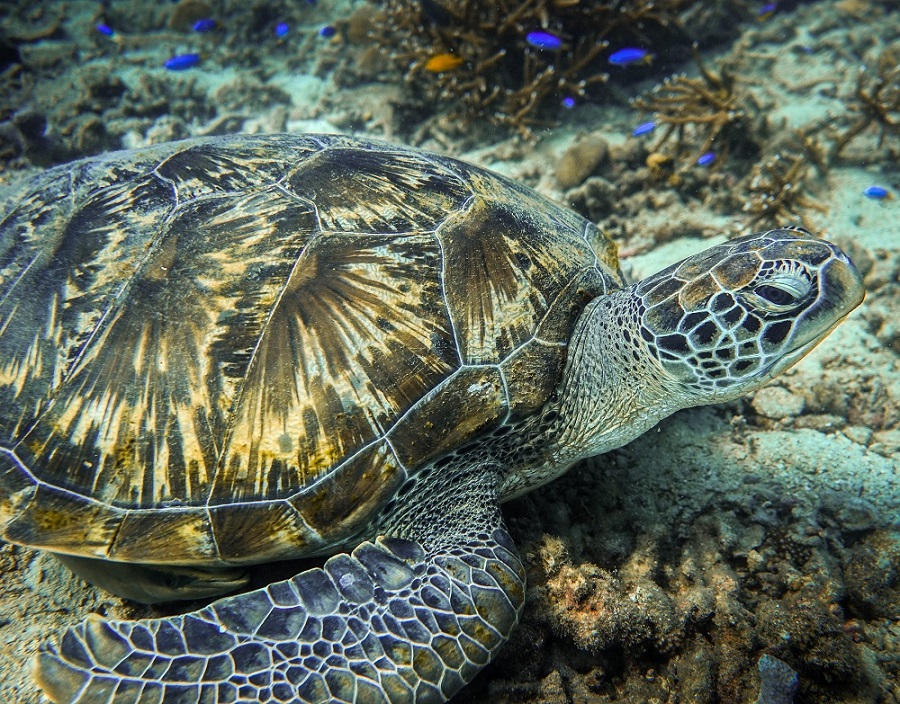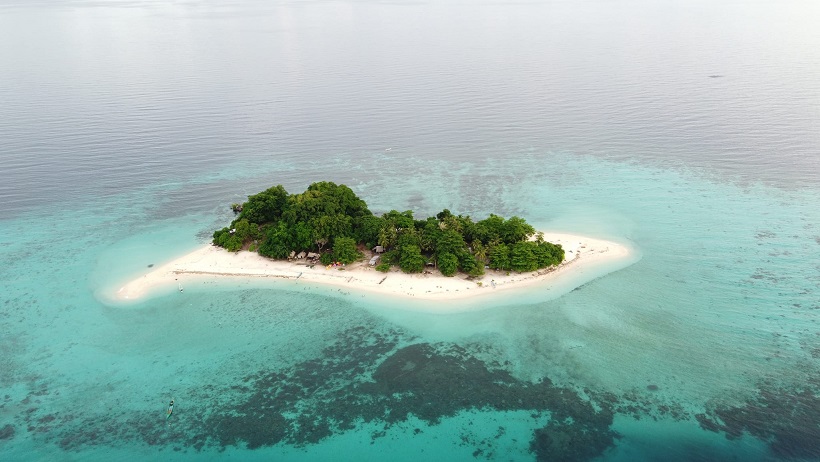Apo Island, located in Dauin, Negros Oriental, is a volcanic island and one of the popular tourist destinations in the Philippines. It is even recognized worldwide as one of the top diving sites because of its exceptional and abundant marine life.
You can never get enough of this island because it is home to a wide array of marine life, including green sea turtles, rays, and thriving coral reefs. You can casually see a lot of green sea turtles munching sea grass near the shoreline. The island is their feeding ground, and you can immediately see them just a short swim away.
A majestic boulder sits in front of this island. You will surely not miss it because it is noticeably the unique feature of Apo Island.
If you have more time and want to explore the place, you can also hike to the island’s highest point. You will see from there a panoramic view of Apo Island, the Sulu Sea, and the neighboring provinces.
How to get to Apo Island
The easiest way to get to Apo Island is by traveling to Dumaguete City by air or sea transport. You can take a private or public service from Dumaguete City to Malatapay Port.
Boats are readily available at the port to take you to Apo Island in less than an hour. If there are no boats for hire on standby, you can coordinate with the port authorities, and they will gladly help you contact and arrange your transport.
Many tour packages in nearby tourist destinations such as Siquijor, Dauin, and Cebu include a day tour to Apo Island. Also, resorts and dive shops on the mainland along Dauin offer day trips to the island. If you would like everything organized and hassle-free in terms of transport, accommodation, or food, take advantage of those tour packages.
When is the ideal time to visit Apo Island?
Divers and visitors can visit Apo Island all year round. Dive centers have already mastered the suitable dive sites for each season. But the ideal time of the year to visit Apo is from November to June. This time of year, the weather is warm, and the sea condition is calm. But if you wish to avoid crowds during the summer months, you might want to visit Apo during the off-season.
Before visiting the island, you can always use apps and websites to check the weather conditions, tides, currents, and waves.
Can you stay overnight on Apo Island?
There are two resorts fronting Apo Island, but Liberty’s Community Lodge and Dive Resort is the only one currently operating. They offer a variety of rooms at reasonable prices. Almost all of their rooms have a private balcony where you can view the beach and marvel at the sunset. They serve breakfast, lunch, and dinner in their restaurant. You can also enjoy a drink at their Sunset Bar. Below the restaurant is their dive shop for your SCUBA diving and snorkeling needs. Staff will be more than happy to assist if you have special requests or need information about the island.
Some residents also offer rooms for rent at a reasonable price. Locals are friendly and accommodating, so don’t hesitate to ask about the location of homestays.
Popular dive sites on Apo Island
Apo Island has multiple dive sites. Each site offers a different scenic view and experience. Regardless of your experience level as a diver, your SCUBA dive master will take you to a suitable dive site.
You’ll have a blast exploring the following dive sites:
Largahan Dive Site
You can find this site northwest of Apo Island. This site has a maximum depth of 24 meters, moderate current, and is ideal for open water and advanced divers. There is a cliff in the area with a depth of 10-20 meters. The most exciting part of this dive site is the geothermal activity that emits continuous streams of bubbles. It’s a heaven for macro lovers, filled with Nembrotha nudibranch, bearded scorpionfish, bump heads, parrotfish, flatworms, frogfish, ribbon eels, and turtles hiding among the coral bommies. There are also soft and hard corals, like black corals and tube anemones.
Katipanan Dive Site
You can snorkel and scuba dive at this site since the depths range from 5 to 20 meters. The current is gentle to moderate, ideal for new and advanced divers. Your eyes will be delighted by the soft coral garden that is breathtakingly beautiful. During your dive, expect to see cuttlefish, nudibranchs, sea snakes, and turtles harmoniously cruising through the corals and across the sand.
Coconut Point Dive Site
With a maximum depth of 24 meters, this site is suitable for experienced divers due to the strong currents. Coconut Point dive site is where advanced divers can experience an exciting drift dive. It is popularly known as “the washing machine” because underwater currents will come from all sides. There are colorful reefs, bigeye trevallies, and big fishes waiting for divers.
Cogon Dive Site
Its name comes from the local term for the blady grass on the shore in front of the site. The site is for advanced divers because it offers an exciting drift dive and a beautiful reef with a maximum depth of 28 meters. This site is home to filefish, sweetlips, sea turtles, schools of big eye trevallies, and scenic landscapes such as sand slope, wall, and coral slope!
Mamsa Point Dive Site
Named after the local term for jackfish that is abundant at the dive site. Advanced divers can only access this site because of the intense and unpredictable current in the area. Its maximum depth is 25 meters. The location is known to have a school of jackfish forming a colossal circle. There are also several reef fish species at this dive site, including giant frogfish, sea turtles, moray eels, eagle rays, and Moorish idols. There are also bubbles escaping on the sandy bottom area of the coral wall because of underwater volcanic activity.
Chapel Dive Site
It got its name Chapel due to its proximity to Apo Island’s only chapel. With a maximum depth of 28 meters, this site is ideal for open water and advanced divers. The site features a majestic wall extending more than 30 meters to the bottom. You can hover between 18-24 meters to marvel at the magnificent wall hanged with soft and hard corals, fans, sponges, and anemones. Leaffish, nudibranchs, frogfish, ribbon eels, turtles, bluefin trevally, and banded sea snakes dominate the area. You can also drift dive in the site, and at the end of the wall, you will see juvenile fish house a small cave.
Rock Point East Dive Site
With a maximum depth of 28 meters, the site is ideal for open water and advanced divers. The site offers a wall and reef where various corals grow. Keep an eye out for octopuses, nudibranchs, schools of jacks, sea turtles, reef sharks, and occasionally seen manta rays.
Rock Point West Dive Site
The site is open for advanced and open water divers. With a maximum depth of 28 meters, the area is home to various marine life. Divers can also experience a drift dive depending on the current. You will also enjoy hard and soft corals, banded sea snakes, jacks, marbled groupers, hawksbill sea turtles, green sea turtles, frogfish, clam shells, juvenile sweet lips, nudibranchs, schools of trevally, and snapper. A Manta Ray or Devil Ray will casually pass by the area if you are lucky.
Apo Island is a marine protected area. Human activities are limited, so make sure not to do anything that could harm aquatic life when you dive underwater. It is best to observe ocean etiquette, such as keeping a distance from marine animals and not touching corals.
Like any other island, Apo is organized and community-based. It is one of the strong foundations of the island. Residents are empowered to safeguard and maintain the marine sanctuary and are given employment opportunities through tourism.
The stunning underwater and thriving marine life surrounding Apo Island is the main attraction to all divers. But there are many other things to do here besides diving. In addition to swimming, snorkeling, and diving, visitors can hike to the island’s highest point to get a scenic viewpoint of the island and the neighboring provinces.
Apo Island offers the best of both worlds for divers or visitors, the exciting underwater attraction and the scenic island landscape, perfect for your much-needed relaxation.
Whether you’re looking for a diving destination or a snorkeling spot, Apo Island is the perfect place to go!


